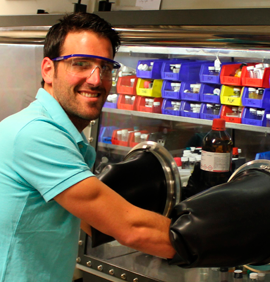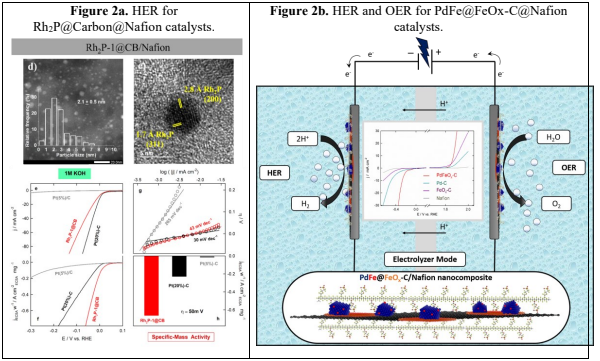 Palestra: Nanoestruturas inorgânicas: Influência das condições de síntese nas propriedades estruturais e morfológicas
Palestra: Nanoestruturas inorgânicas: Influência das condições de síntese nas propriedades estruturais e morfológicas
Resumos da palestra: A síntese de nanoestruturas 1D a base de metais com morfologias variadas tem atraído o interesse em virtude de suas características. Como exemplo dessas estruturas tem-se os nanotubos que apresentam três diferentes superfícies de contato (superfície interna, externa e as extremidades do tubo). O método hidrotérmico tem sido utilizado para obtenção desses materiais e as propriedades das nanoestruturas dependem do mecanismo de formação e das condições hidrotérmicas utilizadas. As sínteses destes materiais sem o uso de templates, com diferentes parâmetros de síntese e com diferentes metais ainda é um campo pouco explorado e inovador, pois estas condições podem gerar materiais com diferentes morfologias (tubos, fios e bastões) e propriedades aumentando a possibilidade de aplicações na catálise. Desta forma, essa palestra tem como objetivo apresentar os trabalhos desenvolvidos no Laboratório de Catálise, Ambiente e Materiais/UERN que mostram a influência dos parâmetros de síntese nas propriedades estruturais e morfológicas de nanoestruturas de cério, nióbio e lantânio.
 Palestra: Palladium-catalyzed telomerization reaction: from fundamentals to application
Palestra: Palladium-catalyzed telomerization reaction: from fundamentals to application
Resumo da Palestra: The telomerization of dienes, attractively defined as 100% atom efficient, is a transition metal catalyzed multicomponent reaction that consists in the reaction of two molecules of a diene with the subsequent addition of a nucleophile, such as an alcohol, an amine, an acid, or water, to form highly valuable intermediates. Butadiene is the most simple and widely studied diene, and butadiene telomerization is today an industrial process key for 1-octene production, and companies such as Kuraray, Dow Chemical, Oxeno, Shell or Evonik have plants for this process. Butadiene telomerization can afford three different products, linear, branched and elimination, with the linear telomer presenting the most interesting properties (Scheme 1). However, despite the interest in the telomerization of non-symmetric dienes, this reaction has been infrequently used due to regioselectivity issues. For isoprene (2-methylbutadiene), the simplest example of non-symmetric diene, the telomerization process can yield up to 12 isomers, making this process a formidable challenge. In this case linear telomers are also the more appreciated since the C-10 products obtained are structurally related to monoterpenes that are key products in the flavors and fragrances industry.
In this communication we will discuss about the clues that allow the control of selectivity in symmetric and non-symmetric dienes.
Data:
Horário:
 Palestra: The Catalyst "Genes" Identified by Artificial Intelligence
Palestra: The Catalyst "Genes" Identified by Artificial Intelligence
Resumo da Palestra: Heterogeneous catalysis is governed by an intricate interplay of multiple underlying processes such as the surface chemical reactions, the dynamic restructuring of the material under reaction conditions, and the transport of reactants and products. Such complexity challenges the modelling of catalysis and the design of improved materials. In this talk, an artificial-intelligence approach is presented to model catalysis and determine the key physicochemical descriptive parameters (“catalyst genes”) correlated with the underlying processes that trigger, facilitate, or hinder the materials' performance.[1] This data-centric approach is based on consistent experimental and theoretical data characterizing the catalyst materials as well as their performance and it can be applied even to the small number of materials that are accessible by experiment, as illustrated for the case of selective oxidation reactions.[1,2,3]
Referências:
[1] L. Foppa, L. M. Ghiringhelli, F. Girgsdies, M. Hashagen, P. Kube, M. Hävecker, S. Carey, A. Tarasov, P. Kraus, F. Rosowski, R. Schlögl, A. Trunschke, and M. Scheffler, MRS Bull. 46, 1 (2021).
[2] L. Foppa, F. Rüther, M. Geske, G. Koch, F. Girgsdies, P. Kube, S. Carey, M. Hävecker, O. Timpe, A. Tarasov, M. Scheffler, F. Rosowski, R. Schlögl, and A. Trunschke, J. Am. Chem. Soc. 145, 3427 (2023).
[3] L. Foppa, C. Sutton, L. M. Ghiringhelli, S. De, P. Löser, S.A. Schunk, A. Schäfer, and M. Scheffler, ACS Catal. 12, 2223 (2022).
Data:
Horário:
 Palestra: Well-defined organometallic precursors for developing tailored catalytic materials.
Palestra: Well-defined organometallic precursors for developing tailored catalytic materials.
Resumo da Palestra: Homo- and hetero-metallic complexes are used as building blocks of well-defined materials, which are employed in small molecules activation (such as H2O, H2 and O2). In this regard, Water splitting is one of the key processes for many applications related to energy storage and conversion. Water oxidation or oxygen evolution reaction (OER) is still considered the mostchallenging step in water splitting since it is a more complex transformation than proton reduction. Cobalt-based metal organic frameworks (MOFs) have recently attracted great interest due to their notable electrocatalytic OER activity and the abundance of this metal in the earth.1,2 Herein, a new cobalt metal−organic framework (2D-Co-MOF) based on well-defined layered double cores that are strongly connected by intermolecular bonds has been developed (Figure 1a). In situ electrochemical activation of a deposited on a graphite electrode produces a well dispersed and ligated nanostructuration of the composite promoting intimate interactions between both components, more abundant electrochemical active sites, where metal centers retain its coordinative chemistry thereby without affecting the intrinsic electrocatalytic properties of the active cobalt centers for OER. The so-activated 2D-Co-MOF@Nafion has been composite exhibits an outstanding electrocatalytic performance for the OER at neutral pH and a high robustness (Figure 1b). The particular coordination chemistryof the MOF consisting of a regular arrangement of multiple Co(II) redox metal sites connectedby appropriate organic ligands can explain the higher catalytic activity of the present MOF.
 Figure 1. (a) X-Ray structure of 2D Cobalt-MOF and (b) its electrocatalytic OER performance.
Figure 1. (a) X-Ray structure of 2D Cobalt-MOF and (b) its electrocatalytic OER performance.
The benchmark HER electrocatalysts are platinum (Pt)-based materials, but these are not goodfor OER, whereas iridium and ruthenium oxides are the state-of-art OER electrocatalysts.Unfortunately, they show insufficient activity toward HER. Indeed, we report a straightforward,efficient and robust synthesis of mono- and bimetallic nanoparticles, promoted through acommercially available metallic source. For instance, the Wilkinson complex in order toprepare Rh2P nanoparticles, which have high crystallinity and are coated with graphitic carbonpatches.3 The resulting materials have been tested in electrocatalytic HER and OER processesat acid, alkaline and neutral media, providing superb HER activity and competitive OERperformance, particularly at neutral and alkaline media, compared to the benchmark HER and OER electrocatalysts Pt and RuOx/IrOx, respectively (Figure 2a).4 Moreover, supported Fe-doped Pd-nanoparticles (NPs) have been prepared via soft transformation of a PdFe-MOF.5 The thus synthesized bimetallic PdFe NPs are supported on, which are essential fordeveloping well-defined and distributed small NPs. The application of this material() as a multifunctional nanocatalyst for the electrocatalytic water splittingprocess has been investigated with promising results, compared with those obtained forpreviously mentioned benchmarking catalysts, in terms of favorable intrinsic activity, wide pHwindow and high stability (Figure 2b).6
 Referências:
Referências:
[1] Gutiérrez Tarriño, S.; Olloqui-Sariego, J. L.; Calvente, J. 1; Palomino, M.; Minguez Espaliargas, G.; Jorda, J. L; Rey, F.; Oña-Burgos, P. Appl. Mat. and Interfaces, 2019, 11, 46658-46665.
[2] Gutiérrez-Tarr-iño, Olloqui-Sariego, J. Calvente, J, J.; Espallargas, Corma, X;
Burgos, P. J. Atn. Chem. soc. 2020, 142, 19198-19208.
[3] Galdeano-Ruano, C.; Corma, A; Oña-Burgos, P. ACS Appl. Nano Mater. 2021, 4, 10743.
[4] Galdeano-Ruano, C.; Olloqui-Sariego, J. L; Oña-Burgos, P. J. Am. Chem. Soc. submitted
[5] Martinez, J.; Mazario, J; Minguez, G. E:, Oña-Burgos, P. Chern. Eur. J. 2020, 26, 13659.
[6] Martinez, J. ; Mazario, J; Olloqui-Sariego, J. L; Oña-Burgos, P. Adv. Sustainable Syst. 2022, 6, 2200096.
Data:
Horário:
 Palestra: Rhodium Catalyzed Hydroformylation and Hydroaminomethylation reactions: Enantioselectivity and Flow processes
Palestra: Rhodium Catalyzed Hydroformylation and Hydroaminomethylation reactions: Enantioselectivity and Flow processes
Resumo da Palestra: The hydroformylation and hydroaminomethylation reactions are important tools in organic synthesis since enantiomerically pure aldehydes and amines are of high interest as precursors for a variety of highly valuable products. Rhodium complexes modified with chiral phosphorus ligands are key catalysts in these asymmetric reactions. The metal catalyzed selective hydroformylation of [2.2.1]-bicyclic olefin is a challenging area due to the interest of the olefin desymmetrization upon one C-C bond formation which may lead to interesting building blocks in organic synthesis. Following our studies using Rh diphosphites and based on optimized conditions, this presentation focus on the results obtained in the asymmetric hydroformylation of norbonene. After catalyst immobilization and due to difficulties found for catalyst recycling, the process has been performed in continuous flow maintaining the enantioselectivity of the reaction.
Second part of the talk deals with the hydroaminomethylation reaction which involve hydroformylation, amine condensation and hydrogenation to obtain amines from alkenes. The successful rhodium catalyzed asymmetric hydroaminomethylation of alkenes using a single Rh catalyst bearing chiral diphosphine ligand will be presented. The preparation of a series of chiral γ-aminobutyric esters was performed through hydroaminomethylation of α-alkyl acrylates in the presence of amines as nucleophiles, achieving ee up to 86%. HP-NMR experiments show the coexistence of neutral and cationic species required to complete the hydroaminomethylation. Recent examples of asymmetric Rh catalyzed hydroaminomethylation achieving ee up 99% will also be included.
Data:
Horário:
